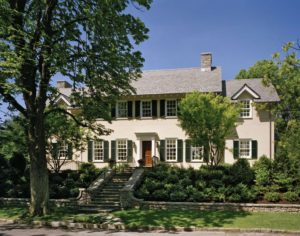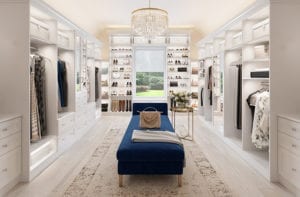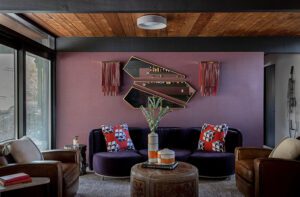A Lakefront Cottage in Litchfield County
July 30, 2019
Text by Bob Curley Photography by Laura Moss Produced by Karin Lidbeck Brent
People have been vacationing at Litchfield County’s Lake Waramaug since the late nineteenth century, and the second-largest lake in Connecticut has seen plenty of changes in that time.
Boarding houses and inns once dotted the shoreline, along with cozy cottages owned by New Yorkers fleeing the summer heat of the city. Now, the inns are gone and many of those cottages have been razed and replaced by large homes. But when a couple living on a nearby country estate wanted to build a lake house for family weekends by the water, they opted for a modest footprint while still putting a memorable stamp on the historic waterfront.
To win local zoning support, the new construction used an existing septic system and was limited in size to approximately that of the cabin it replaced, about 1,800 square feet. “It took a year of public hearings, and I’m still amazed we got it,” says architect Hope Dana. “They thought it was way too modern; what we did to convince them was to build a model.”
The project started with a teardown of an older cottage situated—like many of the homes of the time—right on the edge of Shore Road, which encircles the lake. Dana’s goal was to create separation from the traffic, giving her clients a serene sanctuary.
“The original house was only three feet from the road, but the owners wanted to be on the lake,” she says. However, with a sloped lot just thirty feet wide and eighty feet long, she and her clients decided not to try to build farther down the hill, but rather into it.
By excavating parallel to the road, they were able to build a thirty-foot-tall retaining wall that serves the dual purpose of expanding the level portion of the lot and acting as the rear wall of the two-story cottage. “There were huge challenges with the hillside, but this was an opportunity to create its own environment for the home even though it was so close to the road,” says landscape architect Ben Young. “Integrated with the architecture we created a little pocket, almost like an urban space, with the retaining wall.”
Accessed from the street-level driveway by a rear stairway, the cottage has two bedrooms on the top floor that share a long, covered deck, and an open-plan main level with a kitchen, dining area, and living room all looking onto the lake through two walls of black-framed, floor-to-ceiling windows. “Circulation dictated the character of the house,” says Dana. By placing the stairwell at the rear of the building, she notes, all the rooms could have views of the lake.
Because the cottage’s only porch is up on the second floor, outside the bedrooms, the homeowners asked Dana to design a screen house for enjoying protected outdoor time. The structure, which looks out over the lake, of course, is separated from the main house by a shady courtyard and patio. Young created a lawn by bulkheading the slice of lakefront belonging to the property, using large blocks of local granite reclaimed from old bridge abutments.
The focus of the courtyard is an unusual ornamental, a Kentucky coffee tree Young chose both as a conversation piece and for the canopy provided by its broad, shady leaves. Further softening the angularity of the design is a stone walkway alongside the house—a whimsical path through the woods that provides access down the steep hill to the backyard.
Now sitting just four feet above lake level instead of thirty, the compound departs from the rustic norm with a clean, transitional architecture that uses locally sourced pine and granite to harmonize with its surroundings. “We wanted it to still feel like a cabin, so we lined the whole house with wood,” Dana says.
With its sharply angled roof, wood walls, and open steel railings, the net effect is “Scandinavia by way of Milan,” says interior designer Ellen Hamilton. It’s an impression enhanced by a design plan that incorporates modernist Italian armchairs in the living room, an Eero Saarinen table in the kitchen, and Svenskt Tenn fabrics in the upstairs bedrooms.
The simple interior of light wood accented with black doors and trim gave Hamilton free rein to add splashes of color in the midcentury furnishings, including a vintage sofa re-covered in chartreuse chenille fabric and Eames plastic chairs with orange shells. “When you’re in the space, it’s extremely comfortable, and it makes a great statement about how modern furniture can be very warm,” Hamilton says.
The playful, energetic colors in the cottage were inspired by an eye-catching painting by Gert and Uwe Tobias that hangs beside the kitchen counter. “We wanted the home to have a clean, European look,” the designer says. “We were not particularly interested in an American country vernacular. If we had used traditional beach or lake things, it would have worked—but it wouldn’t have been as much fun.”
Much of the furniture was gathered from the owners’ other homes, which included a previous lake house and a beach house as well as their primary residence in the Litchfield Hills. “We just put it all in there and made it work,” Hamilton says. And while the home certainly does have its designer flourishes, “the views are so strong that we wanted the furnishings to fade into the background and not be too prominent,” she explains.
Because their year-round home is nearby, the owners rarely sleep at the cottage. Instead, it’s their base for weekend fun with family members, who pull the canoes and kayaks out from under the screen house for a few hours on the water before returning for cookouts and conversation in a lake house that is perfectly proportioned for lazy summer days.
Project Team
Architecture: Hope Dana, Platt Dana Architects
Interior design: Ellen Hamilton, Hamilton Design Associates
Builder: Ruscoe Sedito Construction
Landscape design: Ben Young Landscape Architects
Share
![NEH-Logo_Black[1] NEH-Logo_Black[1]](https://www.nehomemag.com/wp-content/uploads/2022/08/NEH-Logo_Black1-300x162.jpg)



















You must be logged in to post a comment.